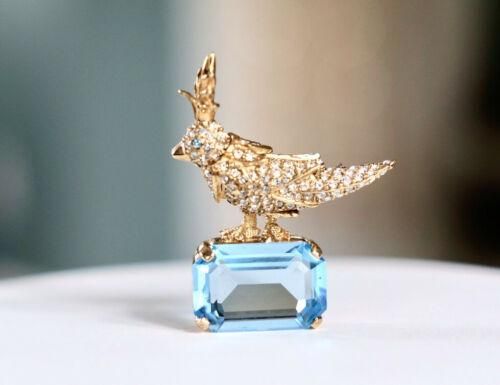
.
.
.
#MarchBirthstones #Bloodstone #Aquamarine #BirthstoneJewelry #GemstoneLove #AntiqueJewelry #VictorianEra #EdwardianStyle #ArtDecoJewelry #FineJewelry #CostumeJewelry #GemstoneHistory #JewelryCollectors #AquamarineGems #GemstoneProtection
March birthstones, bloodstone and aquamarine, are steeped in history and symbolism. Bloodstone, characterized by its green hue with red iron oxide inclusions, is believed to offer protection and strength. However, aquamarine, a serene blue gemstone, has garnered more popularity in modern jewelry due to its captivating color and associations with tranquility and marital harmony. Its name, derived from the Latin words for "water" and "sea," reflects its ocean-like hue, and it has long been associated with safeguarding sailors and fostering calmness. Aquamarine is also the traditional gift for a 19th wedding anniversary and is valued for its ability to soothe the mind.
Aquamarine, a blue variety of the mineral beryl (which also includes emerald and morganite), has been mined globally in locations such as Brazil, Pakistan, Africa, China, Russia, and the United States, particularly in Colorado, where it is the state gemstone. Notable examples include a 1,298-carat aquamarine gifted to Eleanor Roosevelt in 1936 by Brazilian President Getúlio Vargas, now housed in the Franklin D. Roosevelt Presidential Library.
Historical Significance of Aquamarine in Jewelry
Aquamarine’s use in jewelry dates back to ancient Greece and Rome, where it was carved into intaglios and used as talismans featuring Poseidon to protect sailors. During the Georgian and Victorian eras, aquamarines were often a pale blue-green, a natural hue that contrasts with the heat-treated blue stones commonly seen today. Georgian jewelry featuring aquamarines is rare and highly prized, often crafted in gold with intricate cannetille work. Victorian aquamarine jewelry frequently combined the gemstone with seed pearls, diamonds, and garnets, transitioning from heavier designs in the early to mid-period to more delicate styles by the late 19th century.
The gemstone remained popular into the Edwardian era, where it was paired with diamonds and delicate filigree work. Occasionally, glass imitations of aquamarine were used in antique jewelry. The art deco period saw aquamarines incorporated into geometric, symmetrical designs, though they became less prominent in the 1930s as vividly colored stones like emeralds and rubies took center stage.
Mid-Century and Retro Aquamarine Jewelry
During the retro period (mid-1930s to early 1940s), aquamarines regained popularity, often featured as large emerald-cut stones in yellow gold jewelry with bold, scrolling designs. Esteemed jewelers like Tiffany & Co., Bulgari, Seaman Schepps, and David Webb crafted iconic pieces with high-quality aquamarines, while brands like Krementz offered more affordable options that remain collectible today.
Faux Aquamarine in Costume Jewelry
Costume jewelry manufacturers also embraced the allure of aquamarine, creating pieces with simulated stones. Companies like Trifari, Marcel Boucher, Ciner, Mazer, Eisenberg, and Reja produced retro-inspired designs featuring faux aquamarines, often set in gold-plated or sterling silver settings. Trifari and Boucher pieces are particularly sought after, commanding high prices, while more affordable options from brands like Coro and Florenza remain popular among collectors.
Collecting Aquamarine Jewelry
Aquamarine jewelry spans centuries and styles, from ancient talismans to Victorian heirlooms and mid-century modern masterpieces. Antique and vintage pieces are highly collectible, especially those from renowned designers or featuring high-quality stones. Costume jewelry with faux aquamarines also attracts collectors, offering accessible options for those drawn to the gemstone’s soothing blue hue.
Pamela Siegel, a seasoned writer and expert in antiques and collectibles, highlights the enduring appeal of aquamarine in her work. As a co-founder of Costume Jewelry Collectors Int’l (CJCI) and proprietor of Chic Antiques by Pamela, she continues to educate and inspire collectors worldwide.
Conclusion
Aquamarine’s timeless beauty and rich history make it a cherished gemstone for March-born individuals and jewelry enthusiasts alike. Whether in antique Georgian pieces, retro cocktail rings, or costume jewelry imitations, aquamarine’s serene blue hue continues to captivate and inspire. Its versatility and associations with calmness, protection, and love ensure its enduring popularity across generations.


